In part two of this week’s installment of likes and dislikes, we will flip the side of the ball that we’re focusing on and take a look at the best and worst from Week 8 of the 2021 NFL season on defense.
Click here for more PFF tools:
Rankings & Projections | WR/CB Matchup Chart | NFL & NCAA Betting Dashboards | NFL Player Props tool | NFL & NCAA Power Rankings
Like: A whole new (coverage) world for Dan Quinn
| Cowboys' Coverages | Cov. Snaps | Cov. Grade | Yds/Rec, Allowed | Passer Rating Allowed |
| Quarters | 12 | 65.2 | 6.3 | 67.9 |
| Cover 2 | 9 | 89.6 | 5.2 | 67.7 |
| Cover 1 | 7 | 56.8 | 21.5 | 158.3 |
| Cover 3 | 5 | 42.4 | 7.7 | 88.5 |
Dan Quinn’s legacy certainly begins with the Legion of Boom-era Seattle Seahawks and extends through another Super Bowl appearance with the Atlanta Falcons (a game that has certainly left the memories of all who watched). By the end of Quinn's Falcons tenure, it was fair to question whether the sport had passed him by.
What we’re seeing in Dallas, through 2021 and in Week 8, particularly, is a defensive mind making an identity turn that might redefine who Quinn is and how we remember him. The Dallas Cowboys have played great pass defense all year long, and the game against the Minnesota Vikings was a complete encapsulation of Quinn’s growth in a new era of football.
Incorporating Quarters (Cover 4) into his defensive game plan — something Quinn admits he had never been interested in before — allows his players to take away the over routes and seams that strain the single-high coverages we know him for.
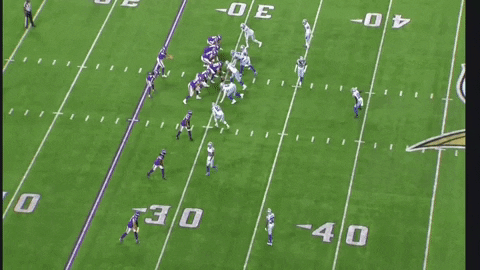
Adding Quarters creates a layering in coverage calls that increases the effectiveness of defensive looks Quinn has always liked — such as Cover 2 on third downs. Between the depth of the safeties, different pressure looks and the threat of man coverage, dropping out into Cover 2 is another way the Cowboys have been able to force quarterbacks' eyes down to underneath throws.
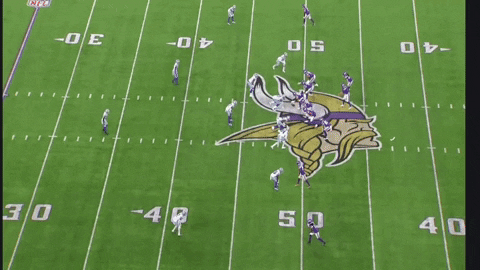
The data will tell you that Dallas still has problems in single-high, but the coverage variations protect this defense from being burned so often in key situations.
Like: The Rams mastering fitting the run out of two-high safeties
The Los Angeles Rams make a return visit to the “likes” column, as I want to appreciate what this defense is doing against opposing offenses on a week-to-week basis.
Of course, this unit was facing off against Davis Mills and the woefully unthreatening Houston Texans‘ offense, but there were still some fascinating clips of the ways Raheem Morris is setting out to fit the run out of a split-safety shell and five players up at the line of scrimmage.
The Two High Podcast (featuring Seth Galina and some other person at PFF) has broached this topic ad nauseam, but the issue with threading this “odd front, two high” needle, in particular, is in the layering of the defense. Having extra players — one at the line of scrimmage and the other deep — means there will be snaps where there’s only one player in the box at the second level. To keep offenses from manipulating the defense with its formations and attacking open air, the “weak safety” (away from the passing strength, where all the WRs are) getting involved in the run fit is critical.
In this clip, you can see that Los Angeles is playing some variation of Cover 2 over the two receivers split out wide. On the weak side, though, the defense is playing like Quarters. In a way, it’s actually Cover 0 because the cornerback is responsible for the No. 1 wide receiver wherever he goes, and the safety is keying the back. You see him roll down to get involved in the run fit when the handoff is confirmed.
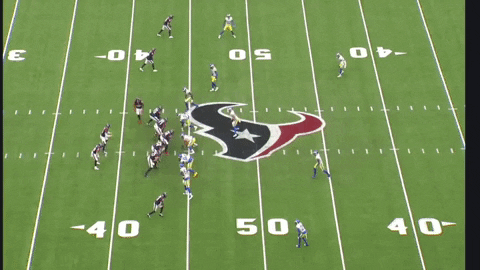
With five down linemen, the ball may not even get out to the safety rolling down. And with all the bubbles (gaps or uncovered linemen) closed, the defense gets one-on-one blocking up front. In a zone-blocking world, all it takes is one win up front to cancel out an offense’s plan to gain yards.
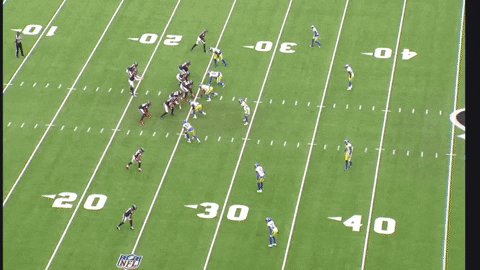
I’ve heard these described as “40” and “50” pressures, meaning the defense is playing Quarters or Cover 2 to one side and “zeroing out” on the opposite side. What you can run to the strong side is open to all possibilities because the weak safety is there to balance out the defense. I’ve called creepers and simulated pressures, the defense’s equivalent of the RPO/play action, and these fall in the same category.
(I’m positive I’ll be talking about the Rams again soon, given what happened at the trade deadline.)
Dislike: The Bears Being Trounced in the Ground Game
| Bears' Run Defense by Safety Rotation | Run-Defense Snaps | Run-Defense Grade | Avg. Depth of Tackle | Defensive Stops |
| Middle of Field Closed | 15 | 44.0 | 6.53 | 10 |
| Middle of Field Open | 8 | 29.3 | 7.60 | 2 |
Take every word I said about the Rams' defense, and then imagine the opposite.
Think of all the ways things can go wrong trying to fit the run out of split-safety shells.
Your imagination dropped you off at Soldier Field, where the Chicago Bears defense is licking its wounds after being bludgeoned by the San Francisco 49ers‘ rushing attack.
For the Bears, a defense that doesn’t have the kind of coverage talent necessary to live in man to man on the perimeter all the time, “zeroing out” like the Rams do isn’t as appetizing an option for fitting the run. A play-action pass undresses a large part of the field, and you have to be able to win single matchups to exist in that kind of world.
The Bears’ more zone-heavy approach introduces a set of rules for safety play — the concept of the “aggressor” and the “protector.” The “50” and “40” pressures play by these rules as well — but much more aggressively.
The aggressor is the safety that will be adding into the run fit as a cutback or alley player. He will be looking to clean up the run fit when or if the ball bounces wide and outside or a linebacker incorrectly fits a gap. The protector is more concerned about play-action passes, so he will not be an active participant in the run fit.
In a way, it mimics the concept of rolling down a safety in single-high coverages. The safety dropping down to the second level is helping in the run fit, and the one back in the middle of the field is not.
What that does in a split-safety defense, though, is put a lot on the plates of linebackers to recognize the flow of the backfield, stay “clean” (nobody blocking him) and play well moving laterally.
Misses in the run fit, especially with one safety dropping deep and away, can open major alleyways. Chicago’s Roquan Smith tries to undercut a reach block on outside zone instead of getting over the top, which would have been the correct response given the motion coming in his direction. When the ball hits the edge, there’s nobody home.
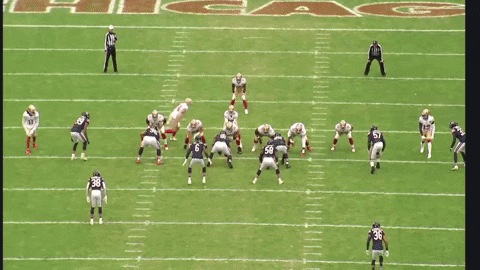
Unfortunately for Chicago, getting into single-high didn’t help much to alleviate the pressure on the second level. Kyle Shanahan and his 49ers offense is built, almost specifically, with attacking single-high defenses in mind.
One way to do that is with “single width” or “nub” formations, where the tight end is on one side and all the receivers are on the opposite. Cover 3 isn’t made to defend these kinds of looks because the spacing of the defense isn’t made to accommodate an underneath defender (curl-flat player) and an over-the-top defender (deep-third player) having to occupy the same space.
What you’ll often see is precisely what Chicago attempted: blitz the overhang to the receiver side, rotate the defender that way and use the blitzer to force the ball back to the nub side.
(The 49ers know this because they're making an “alert” call by tapping their helmets. They don’t have enough blockers to account for the defenders to the tight end side, but they do for the receiver side.)
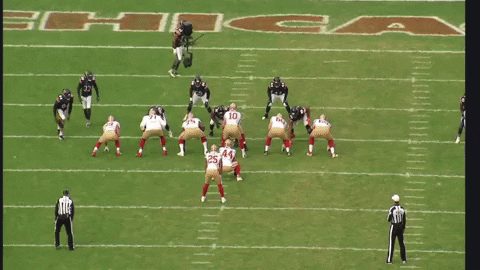
The fullback kicks out the blitzing outside linebacker, and when the front side linemen are able to reach the second level, there’s nobody home again. On the backside, you can see defenders being wasted instead of affecting the run because there’s no other space for these players to fit into.




 © 2025 PFF - all rights reserved.
© 2025 PFF - all rights reserved.